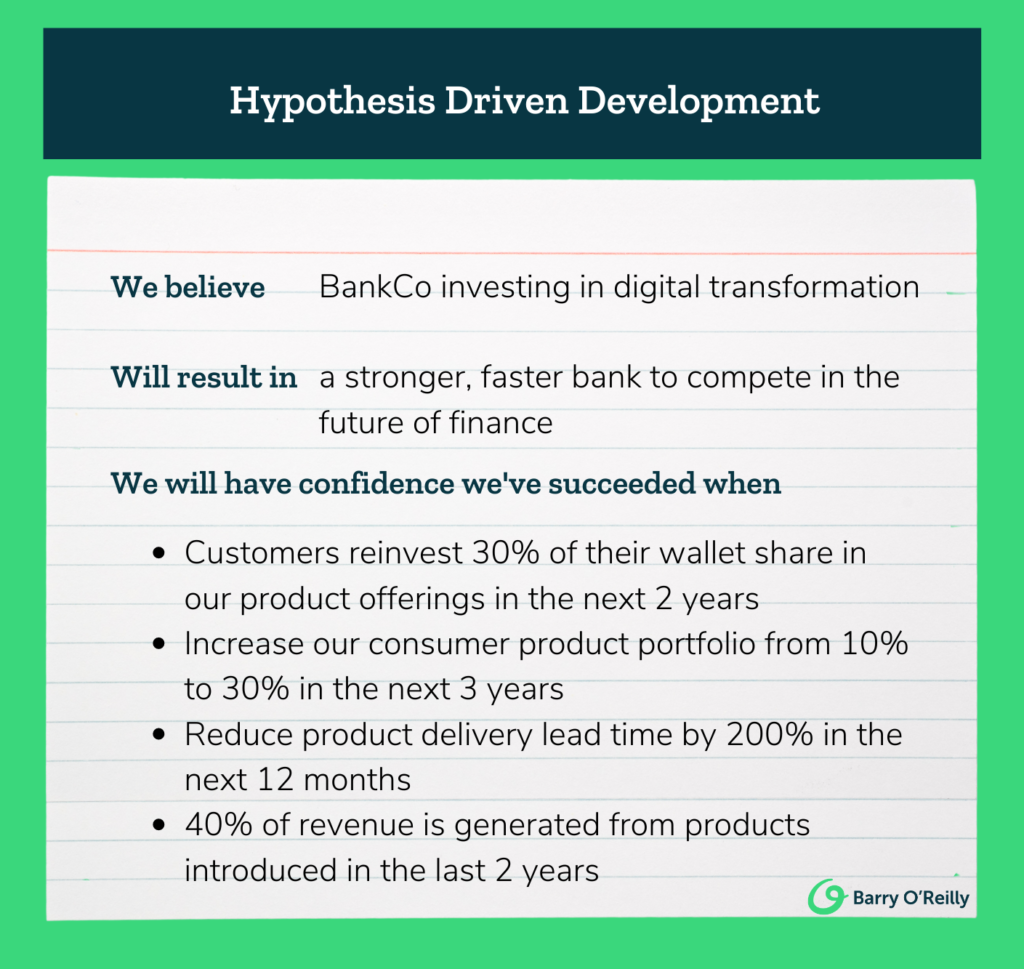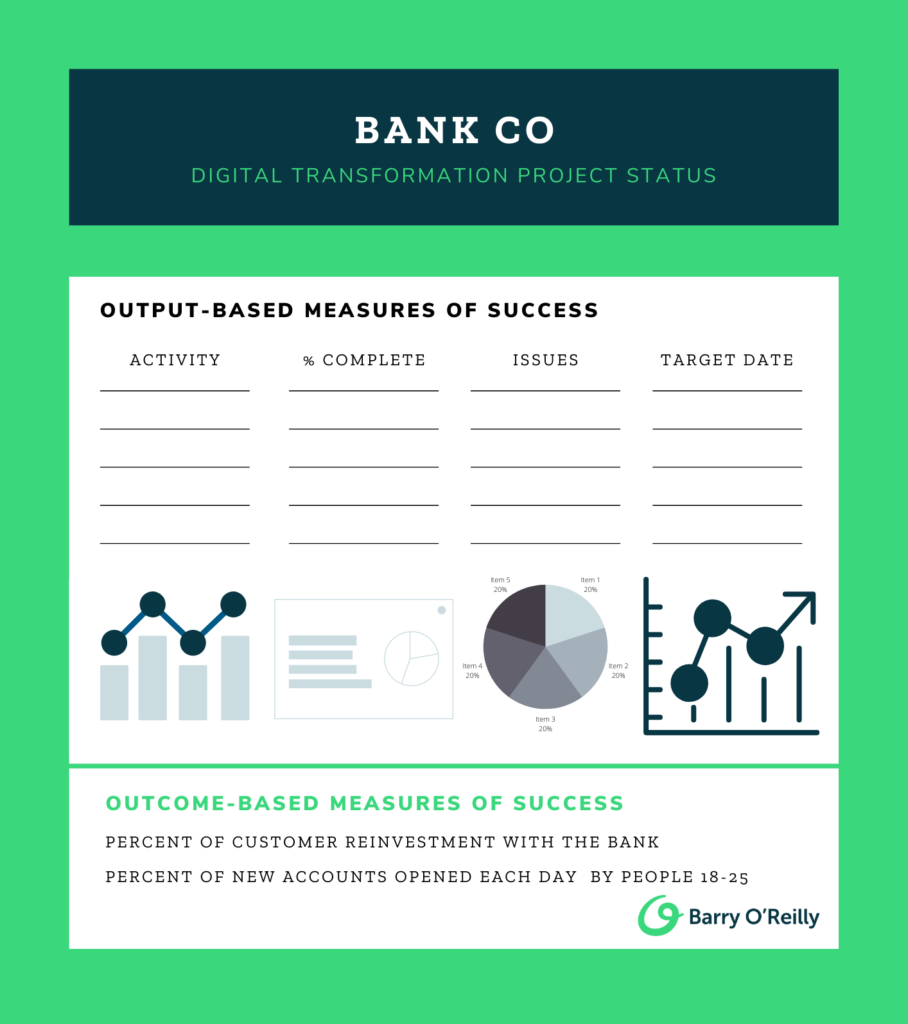I get at least one email every week from a frustrated product or technology leader with a sad tale of culture transformation gone wrong. Their company is trying to create new products faster and build better ways of working—but they’re getting nowhere.
It goes something like this:
We’ve committed to a multi-year digital transformation program but all our measures of success are still focused on what date we’re going to deliver, all the requirements that need to be built, and making sure we stay within budget. If we ask what success is, we’re told it’s getting our project done.
All the ideas are big, 1-2 year initiatives with the first release 6-9 months away. We know as soon as we start that we’re not going to deliver within the timeframes we’ve been given. We immediately start to get pressure from the leadership team, who think we’re slacking off. They push back when we try to suggest shipping something smaller: ”That scope won’t be valuable to our customers.”
Someone managed to sell our executives on SAFe. Now we’re all sitting in two-day trainings, getting certified, renaming everything we do and the roles we’re in. Lots of activity, but nothing’s changing. We’re busy checking off what the framework tells us to do, but we’re going backwards. It’s theater.
What do we do, Barry? Can you help us?
These messages are heartbreaking to read. I feel for people who are fed up with the fallacy of framework rollouts and tick-box transformations. They’ve seen this bad movie too many times to believe it can have a happy ending.
I want to give you some action steps so you can help the people around you understand why these behaviors and mindsets lead to failure, and what to do instead. With small changes, you can start inciting a big culture transformation to create a high-performance organization that innovates at scale.
The Ugly Reality of “Digital Transformation”
The growth of investment in digital transformation is compounding at 18% year-on-year. By 2023, an estimated $7 trillion will be spent on these initiatives annually. To put that in perspective, total US expenditure on healthcare for 2020 was about $4 trillion—during a pandemic.
Companies are spending a fortune on these efforts, but are they good investments? Often, the sad answer is no.
80% fail, most often due to lack of alignment and understanding among leaders on how to execute against a digital transformation strategy. Only 16% of employees said their company’s transformations have improved performance and are sustainable.
Leaders feel the pressure of diminishing market share, and they know something needs to change. But with such poor outcomes, why haven’t they recognized they need a different approach?
Unfortunately, many still aren’t seeing the source of the problem. They’re still fixated on outputs, and they’re being sold billion-dollar pipe dreams by digital transformation “experts” with impressive-but-useless PowerPoint decks and flow charts.
Why are So Many Change Initiatives Failing?
People’s notion of digital transformation is all wrong.
One of the first questions I ask executives is, “How will you know when you’ve digitally transformed?”
Too often, the response is, “We will have delivered project X, launched new feature set Y, and built new platform Z to digitally serve all our customers throughout the world.”
Straightaway, I can tell they’re trapped in a project mentality with output-based measures of success. They’re focused on delivering big initiatives on time, on budget, and in scope with all the fancy requirements they’re hoping for… and no concept of the potential impact of any of it.
There is nothing transformational about this. It’s the standard old model with complex new processes slapped on it.
If You Want to Experiment or Be Agile, Focus On Outcomes
So my first piece of advice is to ask your leadership what business outcomes would signify successful digital transformation (or product creation). Outcomes are changes in behavior that lead to a measurable business impact.
Those changes in behavior could be from customers, teams, business partners, or other actors involved in your business transformation.
To give you an idea of how these conversations can unfold, here’s an example of how I helped one leadership team shift their thinking toward outcomes.
The company was a major bank, and I asked the leaders how they’d know they’d digitally transformed. Initially I got the classic answer: “more revenue and greater profitability”.
Now, these are helpful, but they’re lagging indicators. So I challenged them to think about what leading indicators would tell them that their ideas are working and their business is transforming?
They said, “Customers would be using our products more. We’d be innovating much faster, bringing new products to market sooner. And customers would reinvest more funds from current accounts into our other services.”
These were great starting points for defining success in terms of outcomes. Reinvesting with the bank demonstrated that customers valued their new product offerings and were voting with their cash.
The next step was to quantify and constrain the desired outcomes.
So I asked, “What percentage increase would you like to see in customers reinvesting?” They decided 30% over the next two years would be a phenomenal outcome.
On the product front, they determined they’d love to increase their consumer product portfolio from 10% to 30% in the next three years.
This conversation started to fundamentally change the way those leaders thought about measuring success. Instead of programs to be delivered and lagging indicators like revenue, profitability, and share price, they were thinking of problems to be solved, and leading indicators that would demonstrate success in solving them.
This allowed teams to formulate hypotheses, and start tackling those problems. Non-financial outcomes not only motivate teams more, they encourage people to ideate by providing better focus and raising relevant questions—”How could we get customers to reinvest more of their cash with us?”
We Believe BankCo investing in digital transformation
Will Result In a stronger, faster bank to compete in the future of finance
We Will Have Confidence We’ve Succeeded When
- Customers reinvest 30% of their wallet share in our product offerings in the next 2 years
- Increase our consumer product portfolio from 10% to 30% in the next 3 years
- Reduce product delivery lead time by 200% in the next 12 months
- 40% of revenue is generated from products introduced in the last 2 years

My Small Hack to Start A Big Culture Shift
Now you might be thinking, “Well, Barry, it’s easy for you to have these conversations, but my boss would never listen to me on this.”
Maybe you’re already waist-deep in a big initiative, or your company has been overrun with SAFe coaches handing out training certificates and calling it culture transformation. You’re still not seeing meaningful changes in either behavior or mindset, and you need a way to open a dialogue.
What can you do?
Hack This System and Quietly Start a Revolution
Culture hacks are small, visible changes that model new behaviors or ways of working. These can end up having a massive impact over time.
Here’s a great hack for starting your culture revolution: introduce a single outcome-based measure of success onto your intiative’s reporting dashboard.
The dashboard is a fantastic tool for this purpose, because everyone can see it, from your peers to executives. When I start working with companies, I always get them to send me a copy of their current dashboards so I can see how they’re measuring success.
Invariably, especially with tick-box transformations, everything is defined in terms of output: numbers of features, release dates, story points, velocity, percentage complete, Gantt charts, or worst of all—number of “agile” teams or coaches created! 🤦
These are all helpful to understand if you’re executing well, but they don’t tell you about any of the outcomes you’re hoping to achieve.
Think Big but Start Small
As you tackle this challenge to hack your organization’s culture—don’t fall into the same trap as your company, by trying to roll out a big set of changes all at once.
If you change your entire dashboard, you’ll take away all the controls people are used to. They won’t understand what you’re doing and they’ll be more likely to push back.
The sweet spot of innovation is where the familiar meets the edge of the unknown. Arouse people’s curiosity with something outside their comfort zone that gets them to ask new questions.
Putting one little outcome-based metric on your reporting dashboard and sending it around your company—regardless if it’s red, amber or green—starts a conversation.
Examples of Outcome-Based Metrics
So what could you measure?
If you’re in a bank who’s losing ground to challengers in the younger demographic, you might track what percentage of new accounts opened each day are by people 18-25.
If you’re a retailer wondering why sales are falling, you could measure the percentage change in customer spend year-on-year. You might learn more about which customers segments are staying or leaving.
Or even better, target the segments that really matter to you, where you believe you can win. Start formulating and testing new business ideas with them to see the impact they have.
An executive looking at your dashboard might wonder why your new magic metric is there, which gives you an opening. You can share that while it’s important to understand if you’re executing the project within the constraints, what you’re ultimately trying to do is understand changes in customer behavior, and its resulting business impact.
And by measuring both, you can start thinking about and working with small ways to start moving that needle.
Many will see the value and get interested in further exploration. And if not, that’s good information for you in considering your next career move.
(Read this blog about How to Implement Hypothesis-Driven Development)
One Little Spark…
So if you’re trying to start your own culture shift and ensure your digital transformation or innovation initiatives succeed, this opens a path.
Think big about everything you want to change, but start small. You can become an outcome-oriented, high-performance organization. Add one outcome on your reporting dashboard and see the fire it starts!
Best wishes,
Barry

